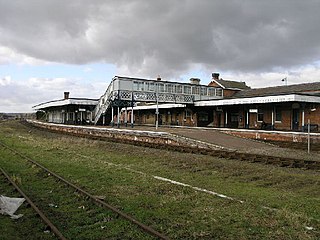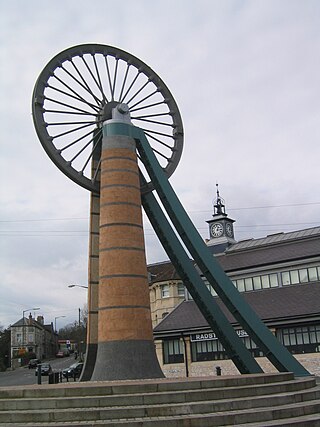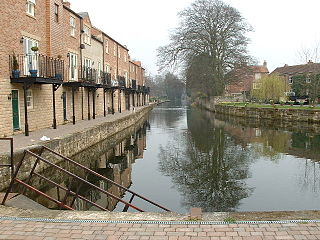
George Stephenson was a British civil engineer and mechanical engineer during the Industrial Revolution. Renowned as the "Father of Railways", Stephenson was considered by the Victorians as a great example of diligent application and thirst for improvement. His chosen rail gauge, sometimes called "Stephenson gauge", was the basis for the 4 feet 8+1⁄2 inches (1.435 m) standard gauge used by most of the world's railways.

The Midland Railway (MR) was a railway company in the United Kingdom from 1844. The Midland was one of the largest railway companies in Britain in the early 20th century, and the largest employer in Derby, where it had its headquarters. It amalgamated with several other railways to create the London, Midland and Scottish Railway at grouping in 1922.

The Somerset Coal Canal was a narrow canal in England, built around 1800. Its route began in basins at Paulton and Timsbury, ran to nearby Camerton, over two aqueducts at Dunkerton, through a tunnel at Combe Hay, then via Midford and Monkton Combe to Limpley Stoke where it joined the Kennet and Avon Canal. This link gave the Somerset coalfield access east toward London. The longest arm was 10.6 miles (17.1 km) long with 23 locks. From Midford an arm also ran via Writhlington to Radstock, with a tunnel at Wellow.

Ruswarp is a railway station on the Esk Valley Line, which runs between Middlesbrough and Whitby via Nunthorpe. The station, situated 1 mile 30 chains (2.2 km) south-west of Whitby, serves the village of Ruswarp, Scarborough in North Yorkshire, England. It is owned by Network Rail and managed by Northern Trains.

Goathland railway station is a station on the North Yorkshire Moors Railway and serves the village of Goathland in the North York Moors National Park, North Yorkshire, England. It has also been used in numerous television and film productions. Holiday accommodation is available in the form of a camping coach.

Sleaford railway station serves the town of Sleaford in Lincolnshire, England. It lies on the Peterborough–Lincoln line. The station is 21 miles (34 km) south of Lincoln Central.

Aike Beck or the Lockington Navigation was a stream in the East Riding of Yorkshire, England, which was constructed as a navigation in the late 18th century, and ceased to function as such in the 1850s. The water supply came from Bryan Mills Beck and Scorborough Beck, but in 1988, these were diverted to feed into Arram Beck, and most of the channel was filled in with material from the flood banks.

Immingham engine shed, also known as Immingham depot, or more recently as Immingham TMD and always locally as Loco is a railway maintenance depot located on the Immingham Dock estate, in North East Lincolnshire, England. The depot code is IM.

Port Carlisle Junction was a railway junction between the lines of the former Caledonian Railway and North British Railway companies lines to the north of Carlisle Citadel station in, what is now, Cumbria, England. It opened in July 1863. Port Carlisle Junction railway station was a very short lived station that first came into use in July 1863 and there was some untimetabled use until 29 October 1863, but the station closed as early as 1 July 1864. After closure, the up (northbound) platform was retained for use by those crews requiring change and also for passing messages on to crews.

The Somerset Coalfield in northern Somerset, England is an area where coal was mined from the 15th century until 1973. It is part of a larger coalfield which stretched into southern Gloucestershire. The Somerset coalfield stretched from Cromhall in the north to the Mendip Hills in the south, and from Bath in the east to Nailsea in the west, a total area of about 240 square miles (622 km2). Most of the pits on the coalfield were concentrated in the Cam Brook, Wellow Brook and Nettlebridge Valleys and around Radstock and Farrington Gurney. The pits were grouped geographically, with clusters of pits close together working the same coal seams often under the same ownership. Many pits shared the trackways and tramways which connected them to the Somerset Coal Canal or railways for distribution.

Flamborough railway station was located in the village of Marton, and was originally named after that location. However, there were several other railway stations also called Marton, so on 1 July 1884 the North Eastern Railway renamed it after the village of Flamborough several miles away. It was situated on the Yorkshire Coast Line from Scarborough to Hull and was opened on 20 October 1847 by the York and North Midland Railway.

Whitby West Cliff railway station was a railway station on the Whitby Redcar and Middlesbrough Union Railway. It was opened on 3 December 1883, to serve the West Cliff area of the town of Whitby, North Yorkshire, England. It was one of two stations serving Whitby; the other was Whitby Town railway station, which served the lines to Malton and Battersby.

The Ripon Canal is located in North Yorkshire, England. It was built by the canal engineer William Jessop to link the city of Ripon with the navigable section of the River Ure at Oxclose Lock, from where boats could reach York and Hull. It opened in 1773 and was a moderate success. It was sold to the Leeds and Thirsk Railway in 1847 and was effectively closed by 1906 owing to neglect. It was not nationalised with most canals and railways in 1948 and was abandoned in 1956.

Alvescot railway station was a railway station between the Oxfordshire villages of Alvescot and Black Bourton, in England. It was Oxford, Witney and Fairford Railway between Oxford and Fairford.
Witney goods station served the Oxfordshire town of Witney on the Oxford, Witney and Fairford Railway. It consisted of seven sidings, a goods shed, a wooden parcel office and a cattle dock. It also had an engine shed, which was demolished early in the twentieth century. Following the opening of the East Gloucestershire Railway in 1873, the station became a goods depot, with passengers using the second station situated to the south. The original station remained open to goods traffic until 1970.

Staveley Town is a disused railway station in Staveley, Derbyshire in England.
New Holland engine shed was a small railway locomotive maintenance depot located southwest of the triangle of lines south of New Holland Town station in North East Lincolnshire, England.

Darley railway station served the village of Darley, North Yorkshire, England from 1864 to 1951 on the Nidd Valley Railway.
John Hargreaves JP was an English carrier, railway entrepreneur and manufacturing businessman. John and his father, also called John Hargreaves, were carriers in the north west of England at the time when railways were being built and taking business away from the canals.
Gallows Close goods yard was a freight transfer yard on the Scarborough and Whitby Railway in the town of Scarborough, North Yorkshire, England. The yard was opened in 1899 to relieve pressure on the main station in Scarborough and to release space for passenger use. After the Scarborough and Whitby Railway closed down, Gallows Close remained in use as a goods yard until final closure came in 1985.
















